 The front of interior designer Steven Sclaroff‘s White Street office is a small store full of furniture and other items that have caught his eye. “It was counterintuitive to have a store on this block, but I knew that going in,” he says. “I had someone sitting in the shop for five years. Now people ring and one of us comes up. The shop part functions more like a trade-y antique business of yore, which wasn’t intentional. We’re happy to have you come in and take a look.”
The front of interior designer Steven Sclaroff‘s White Street office is a small store full of furniture and other items that have caught his eye. “It was counterintuitive to have a store on this block, but I knew that going in,” he says. “I had someone sitting in the shop for five years. Now people ring and one of us comes up. The shop part functions more like a trade-y antique business of yore, which wasn’t intentional. We’re happy to have you come in and take a look.”
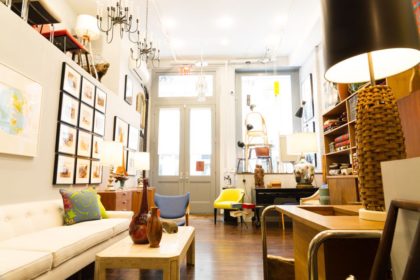 How did you get started in this business?
How did you get started in this business?
I didn’t know I’d end up doing this, but the progression is pretty logical. When I was a teenager in New Jersey, I sold in flea markets. I was a picker dealer: go early, leave early. Then I went to architecture school, and I worked at architecture offices for six years. I got a job at in the architecture department at an interiors firm, and I ended up being studio manager. I went out on my own in 1999 in the Meatpacking District. Back then, you’d still see garbage cans that said “offal” and “inedible,” and you had to be careful where you parked—if they hosed off the area around your car, it’d smell so bad inside you’d have to drive for miles with the window open. In 2001, I moved to Greenwich Street in the West Village, where Margiela is now. I was there for six years.
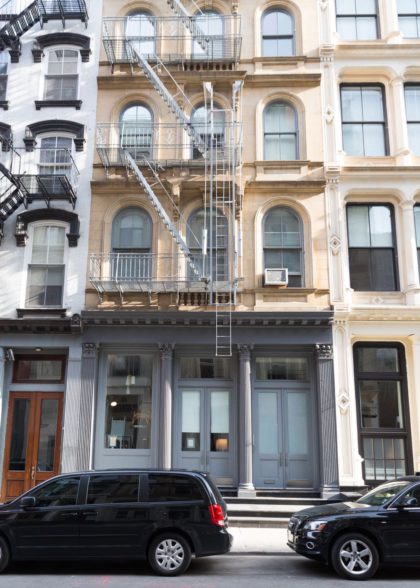 And then you moved to White Street?
And then you moved to White Street?
I had that New York thing of being chased by rent. In the West Village, it went from under $10,000 per month for two storefronts in 2001 to the more than $40,000 that Margiela paid for them when I left 10 years ago—and I don’t know what it is now. So it seemed a failure of vision not to have bought something. This area has a rap for being expensive, but for straight-up, non-luxury loft spaces, I think it’s still one of the better values. It’s dark, though. I used to call it Tribecula. People would say, “Come on, you’re in Tribeca,” but this isn’t N. Moore where you can sun yourself outside on the sidewalk. It’s a good block for British people.
The business is really driven by residential interiors and product design. I’ve been doing a lot for Waterworks. Working with other people, other designers, I helped do a kitchen line—cabinetry, hardware, etc. I never imagined the retail part. When people say, “I can’t believe you’d sell that,” I’m confused. There are very few things I wouldn’t sell you. When you’re shopping for clients, if you come across something awesome, you can’t really decide that you’d rather keep it for yourself.
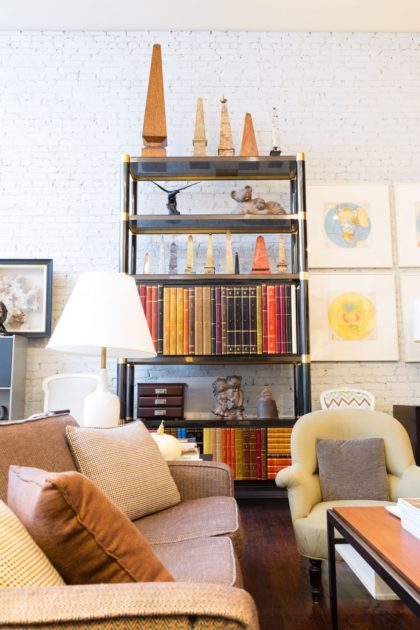 What are you known for?
What are you known for?
I don’t really know. That’s a weird question.
Is it? Don’t many designers have distinct styles? [Looks around.] I can answer it for you, if you like.
Just don’t call me eclectic! As far as the shop goes, most of the time I’m shopping for other people, and if I see things I like, I just get them. I have a fair amount of midcentury—I do love that. But I stay away from the stuff you see a lot. It’s more fun to have stuff be less familiar. It’s fresher.
What’s the most satisfying part of what you do?
I really enjoy the design work—specially collaborating with people to make their living spaces, because everyone wants them to be as great as they can be.
Most popular type of item?
It used to be predictable. We would sell pairs of things—lamps, chairs, tables. Now it’s less so. Most purchases are initiated online, and people are searching for something specific. It can feel random to me. And it makes the vintage antique business less interesting.
The Internet is ruining everything.
Recently a woman came in to rent and buy stuff for a TV shoot. “Don’t worry too much about the sets,” her producer told her, holding a phone in her face. “Everyone will be watching it on a screen this big.”
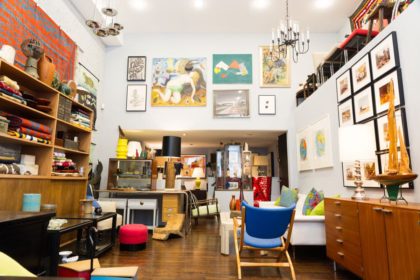 Most expensive item right now?
Most expensive item right now?
I don’t even know.
Make something up!
It’s probably a giant Karl Springer bookcase. I think it’s like 20Gs. It’s pretty big. You could live in it.
Least expensive item?
Because it’s just stuff I like, it’s not priced strategically. There are things for $25 here, but I couldn’t say what they are.
Your very favorite item right now?
I do like those pictures of Mack trucks on the wall. At the Elephant Trunk [a flea market in New Milford, Conn.], I found this binder with a metal Mack truck logo set into the cover. It was full of 8-by-10s of Mack trucks, with no explanation or date.
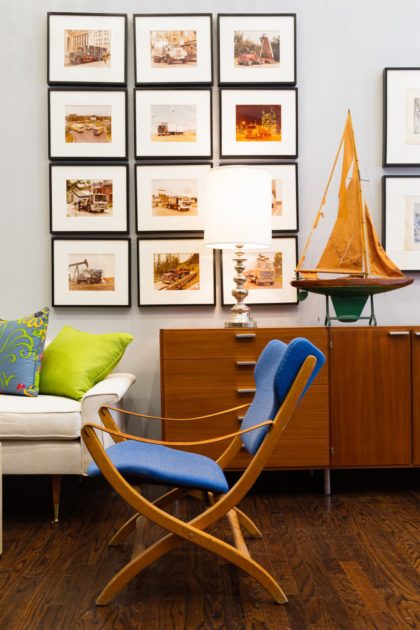 Where do you source stuff?
Where do you source stuff?
It’s pretty random. I go to tag sales in Connecticut, and if I’m traveling, I try to find out where I should look—and then wherever I’ve been, people there will send pictures of stuff. And I shop online, too, like everybody else.
Tribeca has obviously changed a lot. Any changes that have surprised you?
I’ve only been here 10 years. When I came, this area was still kind of gentrifying—now this block is almost done. Lispenard used to be super shabby, and now it’s kind of fancy. We’re witnessing the last bit of gritty in Tribeca.
How has your business changed?
It was already moving online ten years ago. I was used to walk-in business—people walking around, going into stores, like they used to do. Here we sell a little to the neighborhood, but the main point of entry is online. This street is really quiet. Look at Ted Muehling—he literally covers his windows!
And yet Walker Street has gone the other way.
And with design stores!
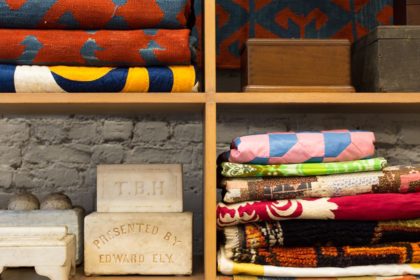 What percentage of your business is to designers?
What percentage of your business is to designers?
More than half. But that’s increasingly gray. People will come, pointed here by their designer. We’re as likely to meet the client as the designer.
Tell me a crazy customer story.
There is that one kind of customer who will make super-insulting offers constantly. I say no, and they keep coming back. If I wanted to give an item away, I could give it to charity. I always joke that I should get a chipper machine so I can make a video of the piece being destroyed and send it to them. People get so obsessed but they won’t pay for it. I think they confuse us with a flea market or garage sale.
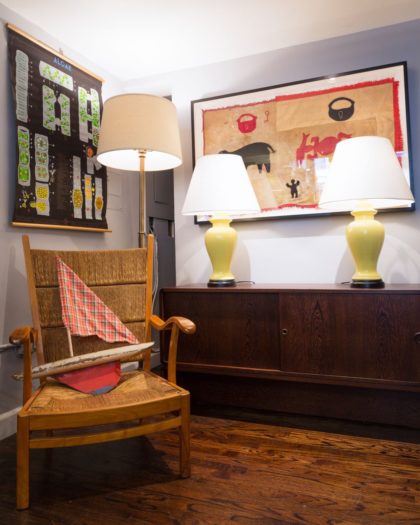 What does the future hold?
What does the future hold?
I don’t know. I feel like the interiors business continues to be vibrant, but I really don’t have any idea about the retail. The reality of retail shopping is changing really fast. It can feel like a race to the bottom: Who’s cheapest?
What didn’t I ask?
Sometimes I think it’s funny that I now live and work in this area, because I have many memories of it from before. I even worked at Murray and Church in the 80s. Tribeca sat dormant for decades, and when I walk around I remember the crazy stores. There was a whole building that sold casters. And Blumberg legal documents—I was sad to see that go. Do you remember World of Damages? Or Meshuggeneh Ike’s? Amazing places! One store on W. Broadway sold odd lots, and I remember it being floor-to-ceiling with ugly platform shoes. Or the loft building on Chambers painted bright yellow, with Cheeses of the World on the ground floor. I’m kind of sad to see that all gone. The area was more varied. It’s improved now in many ways—it’s cleaner, it’s safer, you don’t have to worry about your dogs eating chicken bones on the sidewalk. But you give something up.
 Photos by Claudine Williams, a contemporary portrait photographer based in Lower Manhattan. Her specialty is women’s portraiture as well as personal branding and magazine-style family photography.
Photos by Claudine Williams, a contemporary portrait photographer based in Lower Manhattan. Her specialty is women’s portraiture as well as personal branding and magazine-style family photography.











